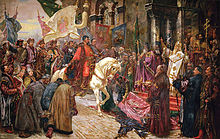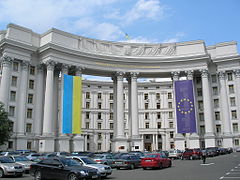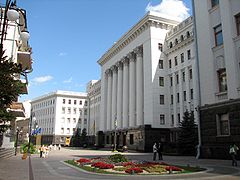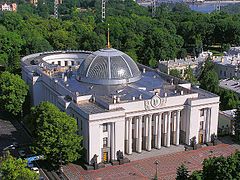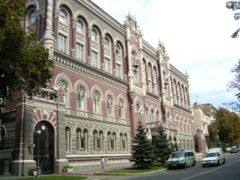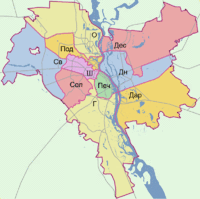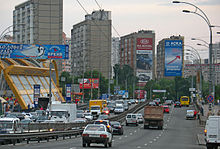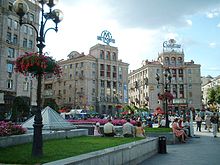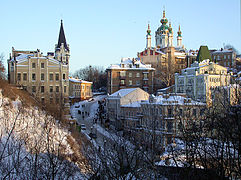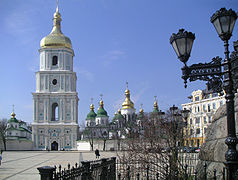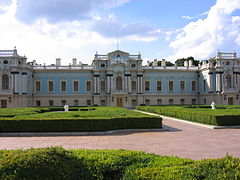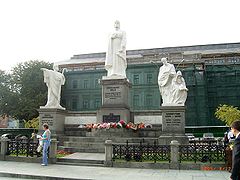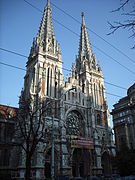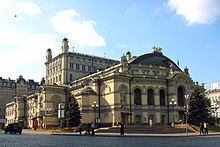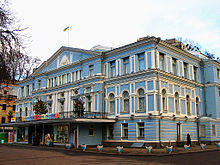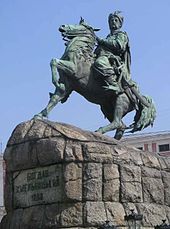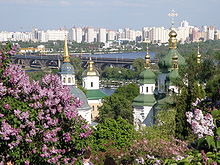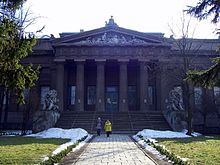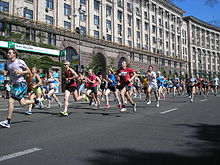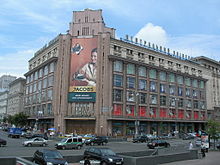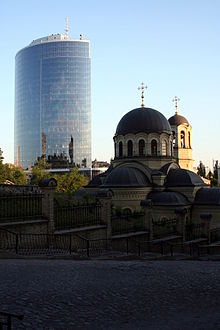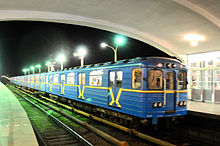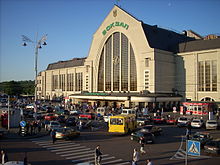
Kiev
Background Information
SOS Children, an education charity, organised this selection. SOS Children is the world's largest charity giving orphaned and abandoned children the chance of family life.
Kiev
|
|||
|---|---|---|---|
 |
|||
|
|||
|
|
|||
| Coordinates: 50°27′00″N 30°31′24″E Coordinates: 50°27′00″N 30°31′24″E | |||
| Country | |||
| Municipality | Kiev City Municipality | ||
| Founded | 9th century | ||
| Raions |
List of 10
|
||
| Government | |||
| • Mayor | Halyna Hereha (acting) | ||
| • Head of City State Administration | Oleksandr Popov | ||
| Area | |||
| • City | 839 km2 (324 sq mi) | ||
| Elevation | 179 m (587 ft) | ||
| Population (1 January 2010) | |||
| • City | 2,797,553 | ||
| • Density | 3,299/km2 (8,540/sq mi) | ||
| • Metro | 3,648,000 | ||
| Time zone | EET ( UTC+2) | ||
| • Summer ( DST) | EEST ( UTC+3) | ||
| Postal code | 01xxx-04xxx | ||
| Area code(s) | +380 44 | ||
| License plate | AA (before 2004: КА, КВ, КЕ, КН, КІ, KT) | ||
| Website | www.kmv.gov.ua | ||
Kiev or Kyiv ( Ukrainian: Київ (Kyiv) [ˈkɪjiw]; Russian: Киев (Kiyev)) is the capital and the largest city of Ukraine, located in the north central part of the country on the Dnieper River. The population as of the 2001 census was 2,611,300, though higher numbers have been cited in the press.
Kiev is an important industrial, scientific, educational, and cultural centre of Eastern Europe. It is home to many high-tech industries, higher education institutions and world-famous historical landmarks. The city has an extensive infrastructure and highly developed system of public transport, including the Kiev Metro.
The city's name is said to derive from the name of Kyi, one of its four legendary founders (see Etymology, below). During its history, Kiev, one of the oldest cities in Eastern Europe, passed through several stages of great prominence and relative obscurity. The city probably existed as a commercial centre as early as the 5th century. A Slavic settlement on the great trade route between Scandinavia and Constantinople, Kiev was a tributary of the Khazars, until seized by the Varangians (Vikings) in the mid-9th century. Under Varangians rule, the city became a capital of the Rus', the first East Slavic state. Completely destroyed during the Mongol invasion in 1240, the city lost most of its influence for the centuries to come. It was a provincial capital of marginal importance in the outskirts of the territories controlled by its powerful neighbours; first the Grand Duchy of Lithuania, followed by Poland and Russia.
The city prospered again during the Russian Empire's industrial revolution in the late 19th century. In 1917, after the Ukrainian National Republic declared independence from the Russian Empire, Kiev became its capital. And from 1921 onwards Kiev was an important city of the Ukrainian Soviet Socialist Republic, and, from 1934, its capital. During World War II, the city again suffered significant damage, but quickly recovered in the post-war years, remaining the third largest city of the Soviet Union. Following the collapse of the Soviet Union and the Ukrainian independence of 1991, Kiev remained the capital of Ukraine.
Etymology
Currently, Kiev is the traditional and most commonly used English name for the city, but in 1995 the Ukrainian government adopted Kyiv as the mandatory romanization for use in legislative and official acts.
As a prominent city with a long history, its English name was subject to gradual evolution. The early English spelling was derived from Old East Slavic form Kyjevъ ( Cyrillic: Къıєвъ), derived from Kyi (Кий), the legendary founder of the city.
Early English sources use various names, including Kiou, Kiow, Kiew, Kiovia. On one of the oldest English maps of the region, Russiae, Moscoviae et Tartariae published by Ortelius (London, 1570) the name of the city is spelled Kiou. On the 1650 map by Guillaume de Beauplan, the name of the city is Kiiow, and the region was named Kÿowia. In the book Travels, by Joseph Marshall (London, 1772), the city is referred to as Kiovia. While the choice of these spellings have likely been influenced by the Polish name of the city ( Polish: Kijów) as until mid-17th century the city was controlled by Poland, the name Kiev [ˈkijef] that started to take hold at later times, likely originates on the basis of Russian orthography and pronunciation [ˈkijef], during a time when Kiev was in the Russian Empire (since 1708 a centre of a Governorate).
In English, Kiev was used in print as early as in 1804 in the John Cary's "New map of Europe, from the latest authorities" in "Cary's new universal atlas" published in London. The English travelogue titled New Russia: Journey from Riga to the Crimea by way of Kiev, by Mary Holderness was published in 1823. By 1883, the Oxford English Dictionary included Kiev in a quotation. Kiev is also based on the old Ukrainian language spelling of the city name and was used by Ukrainians and their ancestors from the time of Kievan Rus until only about the last century.
Kyiv ([ˈkɪjiw]) is the romanized version of the name of the city used in modern Ukrainian. Starting from the 20th century it has been used in English-language publications of the Ukrainian diaspora and in some academic publications concerning Ukraine. Following independence in 1991, the Ukrainian government introduced the national rules for transliteration of geographic names from Ukrainian into English. According to the rules, the Ukrainian Київ transliterates into Kyiv. This has established the use of the spelling Kyiv in all official documents issued by the governmental authorities since October 1995. The spelling is used by the United Nations, all English-speaking foreign diplomatic missions, several international organizations, Encarta encyclopedia, and by some media in Ukraine. In October 2006, the United States federal government changed its official spelling of the city name to Kyiv, upon the recommendation of the US Board of Geographic Names. The British government has also started using Kyiv. The alternate romanizations Kyyiv (BGN/PCGN transliteration) and Kyjiv (scholarly) are also in use in English-language atlases. Most major English-language news sources like BBC continue to use Kiev.
History
Kiev is one of the oldest cities of Eastern Europe and has played a pivotal role in the development of the medieval East Slavic civilization as well as in the modern Ukrainian nation.
It is believed that Kiev was founded in the late 9th century (some historians have wrongly referred to as 482 CE). The origin of the city is obscured by legends, one of which tells about a founding-family consisting of a Slavic tribe leader Kyi, the eldest, his brothers Shchek and Khoryv, and also their sister Lybid, who founded the city (The Primary Chronicle). According to it the name Kyiv/Kiev means to "belong to Kyi". Some claim to find reference to the city in Ptolemy’s work as the Metropolity (the 2nd century). Another legend points that Saint Andrew passed through the area and where he erected a cross, a church was built. Also since the Middle Ages an image of the Saint Michael represented the city as well as the duchy.
There is little historical evidence pertaining to the period when the city was founded. Scattered Slavic settlements existed in the area from the 6th century, but it is unclear whether any of them later developed into the city. 8th century fortifications were built upon a Slavic settlement apparently abandoned some decades before. It is still unclear whether these fortifications were built by the Slavs or the Khazars. If it was the Slavic peoples then it is also uncertain when Kiev fell under the rule of the Khazar empire or whether the city was, in fact, founded by the Khazars. The Primary Chronicle (a main source of information about the early history of the area) mentions Slavic Kievans telling Askold and Dir that they live without a local ruler and pay a tribute to the Khazars in an event attributed to the 9th century. At least during the 8th and 9th centuries Kiev functioned as an outpost of the Khazar empire. A hill-fortress, called Sambat (Old Turkic for "High Place") was built to defend the area. At some point during the late 9th or early 10th century Kiev fell under the rule of Varangians (see Askold and Dir, and Oleg of Novgorod) and became the nucleus of the Rus' polity. The date given for Oleg's conquest of the town in the Primary Chronicle is 882, but some historians, such as Omeljan Pritsak and Constantine Zuckerman, dispute this and maintain that Khazar rule continued as late as the 920s (documentary evidence exists to support this assertion – see the Kievian Letter and Schechter Letter.) Other historians suggest that the Magyar tribes ruled the city between 840 and 878, before migrating with some Khazar tribes to Hungary. According to these the building of the fortress of Kiev was finished in 840 by the lead of Keő (Keve), Csák and Geréb, the three brothers, possibly members of the Tarján tribe (the three names are mentioned in the Kiev Chronicle as Kyi, Shchek and Khoryv, none of them are Slavic names and it has been always a hard problem to solve their meaning/origin by Russian historians. Though the three names were put into the Kiev Chronicle in the 12th century and they were identified as old-Russian mythological heroes).
During the 8th and 9th centuries, Kiev was an outpost of the Khazar empire. However, being located on the historical trade route from the Varangians to the Greeks and starting in the late 9th century or early 10th century, Kiev was ruled by the Varangian nobility and became the nucleus of the Rus' polity, whose 'Golden Age' (11th to early 12th centuries) has from the 19th century become referred to as Kievan Rus'. In 968, the nomadic Pechenegs attacked and then besieged the city. In 1203 Kiev was captured and burned by Prince Rurik Rostislavich and his Kipchak allies. In the 1230s the city was besieged and ravaged by different Rus' princes several times. In 1240 the Mongol invasion of Rus led by Batu Khan completely destroyed Kiev, an event that had a profound effect on the future of the city and the East Slavic civilization. At the time of the Mongol destruction, Kiev was reputed as one of the largest cities in the world, with a population exceeding one hundred thousand.
In the early 1320s, a Lithuanian army led by Gediminas defeated a Slavic army led by Stanislav of Kiev at the Battle on the Irpen' River, and conquered the city. The Tatars, who also claimed Kiev, retaliated in 1324–1325, so while Kiev was ruled by a Lithuanian prince, it had to pay a tribute to the Golden Horde. Finally, as a result of the Battle of Blue Waters in 1362, Kiev and surrounding areas were incorporated into the Grand Duchy of Lithuania by Algirdas, Grand Duke of Lithuania. In 1482, the Crimean Tatars sacked and burned much of Kiev. In 1569 ( Union of Lublin), when the Polish–Lithuanian Commonwealth was established, the Lithuanian-controlled lands of the Kiev region, Podolia, Volhynia, and Podlachia, were transferred from Grand Duchy of Lithuania to the Crown of the Kingdom of Poland, and Kiev became the capital of Kiev Voivodeship. In 1658 ( Treaty of Hadiach), Kiev was supposed to become the capital of the Duchy of Rus' within Polish–Lithuanian–Ruthenian Commonwealth, but the treaty was never ratified to this extent. Kept by the Russian troops since 1654 ( Treaty of Pereyaslav), it became a part of the Tsardom of Russia from 1667 on ( Truce of Andrusovo) and enjoyed a degree of autonomy. None of Polish-Russian treaties concerning Kiev has been never ratified. In the Russian Empire Kiev was a primary Christian centre, attracting pilgrims, and the cradle of many of the empire's most important religious figures, but until the 19th century the city's commercial importance remained marginal.
In 1834, the Saint Vladimir University was established; it is now called the Taras Shevchenko National University of Kiev after the Ukrainian poet Taras Shevchenko. Shevchenko was a field researcher and editor for the geography department.
During the 18th and 19th centuries city life was dominated by the Russian military and ecclesiastical authorities; the Russian Orthodox Church formed a significant part of Kiev's infrastructure and business activity. In the late 1840s, the historian, Mykola Kostomarov (Russian: Nikolay Kostomarov), founded a secret political society, the Brotherhood of Saint Cyril and Methodius, whose members put forward the idea of a federation of free Slavic people with Ukrainians as a distinct and separate group rather than a subordinate part of the Russian nation; the society was quickly suppressed by the authorities.
Following the gradual loss of Ukraine's autonomy, Kiev experienced growing Russification in the 19th century by means of Russian migration, administrative actions and social modernization. At the beginning of the 20th century, the city centre was dominated by the Russian-speaking part of the population, while the lower classes living on the outskirts retained Ukrainian folk culture to a significant extent. However, enthusiasts among ethnic Ukrainian nobles, military and merchants made recurrent attempts to preserve native culture in Kiev (by clandestine book-printing, amateur theatre, folk studies etc.)

During the Russian industrial revolution in the late 19th century, Kiev became an important trade and transportation centre of the Russian Empire, specialising in sugar and grain export by railway and on the Dnieper river. As of 1900, the city had also become a significant industrial centre, having a population of 250,000. Landmarks of that period include the railway infrastructure, the foundation of numerous educational and cultural facilities as well as notable architectural monuments (mostly merchant-oriented). The first electric tram line of the Russian Empire was established in Kiev (arguably, the first in the world).
Kiev prospered during the late 19th century industrial revolution in the Russian Empire, when it became the third most important city of the Empire and the major centre of commerce of its southwest. In the turbulent period following the 1917 Russian Revolution, Kiev became the capital of several short-lived Ukrainian states and was caught in the middle of several conflicts: World War I, the Russian Civil War, and the Polish-Soviet War. Kiev changed hands sixteen times from the end of 1918 to August 1920.
Starting in 1921, the city was a part of the Ukrainian Soviet Socialist Republic, a founding republic of the Soviet Union. Kiev was greatly affected by all the major processes that took place in Soviet Ukraine during the interwar period: the 1920s Ukrainization as well as the migration of the rural Ukrainophone population made the Russophone city Ukrainian-speaking and propped up the development of the Ukrainian cultural life in the city; the Soviet Industrialization that started in the late 1920s turned the city, a former centre of commerce and religion, into a major industrial, technological and scientific centre, the 1932–1933 Great Famine devastated the part of the migrant population not registered for the ration cards, and Joseph Stalin's Great Purge of 1937–1938 almost eliminated the city's intelligentsia
In 1934 Kiev became the capital of Soviet Ukraine. The city boomed again during the years of the Soviet industrialization as its population grew rapidly and many industrial giants were created, some of which exist to this day.
In World War II, the city again suffered significant damage, and was occupied by Nazi Germany from 19 September 1941 to 6 November 1943. More than 600,000 Soviet soldiers were killed or captured in the great encirclement battle of Kiev in 1941. Most of them never returned alive. Shortly after the city was occupied, a team of NKVD officers that had remained hidden dynamited most of the buildings on the Khreshchatyk, the main street of the city, most of whose buildings were being used by German military and civil authorities; the buildings burned for days and 25,000 people were left homeless.
Allegedly in response to the actions of the NKVD, the Germans rounded up all the local Jews they could find, nearly 34,000, and massacred them at Babi Yar over the course of 29–30 September 1941.
Kiev recovered economically in the post-war years, becoming once again the third most important city of the Soviet Union. The catastrophic accident at the Chernobyl Nuclear Power Plant occurred only 100 km (62 mi) north of the city. However, the prevailing northward winds blew most of the radioactive debris away from the city.
In the wake of the collapse of the Soviet Union the Declaration of Independence of Ukraine was proclaimed in the city by the Ukrainian parliament on 24 August 1991. Kiev is the capital of independent Ukraine. Later, in 2004–2005 the city played host to the largest public demonstrations in support of the Orange Revolution.
Environment
Geography
Geographically, Kiev belongs to the Polesia ecological zone (a part of the European mixed woods). However, the city's unique landscape distinguishes it from the surrounding region.
Kiev is located on both sides of the Dnieper River, which flows south through the city towards the Black Sea. The older right-bank (western) part of the city is represented by numerous woody hills, ravines and small rivers. It is a part of the larger Dnieper Upland adjoining the western bank of the Dnieper in its mid-flow. Kiev expanded to the Dnieper's lowland left bank (to the east) only in the 20th century. Significant areas of the left-bank Dnieper valley were artificially sand-deposited, and are protected by dams.
The Dnieper River forms a branching system of tributaries, isles, and harbors within the city limits. The city is adjoined by the mouth of the Desna River and the Kiev Reservoir in the north, and the Kaniv Reservoir in the south. Both the Dnieper and Desna rivers are navigable at Kiev, although regulated by the reservoir shipping locks and limited by winter freeze-over.
In total, there are 448 bodies of open water within boundaries of Kiev, which include Dnieper itself, its reservoirs, and several small rivers, dozens of lakes and artificially created ponds. They occupy 7949 hectares of territory. Additionally, the city boasts of 16 developed beaches (totalling 140 hectares) and 35 near-water recreational areas (covering more than 1000 hectares). Many are used for pleasure and recreation, although some of the bodies of water are not suitable for swimming.
Climate
Kiev has a humid continental climate ( Koppen Dfb). The warmest months are June, July, and August, with mean temperatures of 13.8 to 24.8 °C (57 to 77 °F). The coldest are December, January, and February, with mean temperatures of -4.6 to -1.1 °C (24 to 30 °F). The highest ever temperature recorded in the city was 39.4 °C (102.9 °F) on 31 July 1936. The coldest temperature ever recorded in the city was −32.2 °C (−26.0 °F) on 7 & 9 February 1929. Snow cover usually lies from mid-November to the end of March, with the frost-free period lasting 180 days on average, but surpassing 200 days in recent years.
| Climate data for Kiev | |||||||||||||
|---|---|---|---|---|---|---|---|---|---|---|---|---|---|
| Month | Jan | Feb | Mar | Apr | May | Jun | Jul | Aug | Sep | Oct | Nov | Dec | Year |
| Record high °C (°F) | 11.1 (52) |
17.3 (63.1) |
22.4 (72.3) |
30.2 (86.4) |
33.6 (92.5) |
35.0 (95) |
39.4 (102.9) |
39.3 (102.7) |
33.8 (92.8) |
27.9 (82.2) |
23.2 (73.8) |
14.7 (58.5) |
39.3 (102.7) |
| Average high °C (°F) | −0.9 (30.4) |
0.0 (32) |
5.6 (42.1) |
14.0 (57.2) |
20.7 (69.3) |
23.5 (74.3) |
25.6 (78.1) |
24.9 (76.8) |
19.0 (66.2) |
12.5 (54.5) |
4.9 (40.8) |
0.0 (32) |
12.5 (54.5) |
| Daily mean °C (°F) | −3.5 (25.7) |
−3 (27) |
1.8 (35.2) |
9.3 (48.7) |
15.5 (59.9) |
18.5 (65.3) |
20.5 (68.9) |
19.7 (67.5) |
14.2 (57.6) |
8.4 (47.1) |
1.9 (35.4) |
−2.3 (27.9) |
8.4 (47.1) |
| Average low °C (°F) | −5.8 (21.6) |
−5.7 (21.7) |
−1.4 (29.5) |
5.1 (41.2) |
10.8 (51.4) |
14.2 (57.6) |
16.1 (61) |
15.2 (59.4) |
10.2 (50.4) |
4.9 (40.8) |
0.0 (32) |
−4.6 (23.7) |
4.9 (40.8) |
| Record low °C (°F) | −31.1 (−24) |
−32.2 (−26) |
−24.9 (−12.8) |
−10.4 (13.3) |
−2.4 (27.7) |
2.4 (36.3) |
5.8 (42.4) |
3.3 (37.9) |
−2.9 (26.8) |
−17.8 (0) |
−21.9 (−7.4) |
−30.0 (−22) |
−32.2 (−26) |
| Precipitation mm (inches) | 36 (1.42) |
39 (1.54) |
36 (1.42) |
46 (1.81) |
57 (2.24) |
82 (3.23) |
72 (2.83) |
61 (2.4) |
58 (2.28) |
40 (1.57) |
48 (1.89) |
44 (1.73) |
619 (24.37) |
| Avg. rainy days | 8 | 7 | 9 | 13 | 14 | 15 | 14 | 11 | 14 | 12 | 12 | 9 | 138 |
| Avg. snowy days | 17 | 17 | 10 | 2 | 0.2 | 0 | 0 | 0 | 0.03 | 2 | 9 | 16 | 73 |
| % humidity | 83 | 80 | 74 | 64 | 62 | 67 | 68 | 67 | 74 | 77 | 85 | 86 | 74 |
| Mean monthly sunshine hours | 31.0 | 56.5 | 124.0 | 180.0 | 279.0 | 270.0 | 310.0 | 248.0 | 210.0 | 155.0 | 60.0 | 31.0 | 1,954.5 |
| Source #1: Pogoda.ru.net | |||||||||||||
| Source #2: BBC weather (sun values). | |||||||||||||
Government
The municipality of the city of Kiev has a special legal status within Ukraine compared to the other administrative subdivisions of the country. The most significant difference is that the city is subordinated directly to the national-level branches of the Government of Ukraine, skipping the regional level authorities of Kiev Oblast. Additionally, the Head of City Administration—the leading executive position is held by a directly elected, rather than appointed, figure, who is also the Head of the City Council—the Mayor of Kiev, and municipal institutions have a higher level of self governance than elsewhere in Ukraine.
| National government buildings in Kiev | |||||||||||
|---|---|---|---|---|---|---|---|---|---|---|---|
|
Subdivisions
The first known formal subdivision of Kiev dates to 1810 when the city was subdivided into 4 parts: Pechersk, Starokyiv, and the first and the second parts of Podil. In 1833–1834 according to Tsar Nicholas I's decree, Kiev was subdivided into 6 police raions; later being increased to 10. As of 1917, there were 8 Raion Councils (Duma), which were reorganised by bolsheviks into 6 Party-Territory Raions.
During the Soviet era, as city was expanding, the number of raions also gradually increased. These newer districts of the city, along with some older areas were then named in honour of prominent communists and socialist-revolutionary figures; however, due to the way in which many communist party members eventually, after a certain period of time, fell out of favour and so were replaced with new, fresher minds, so too did the names of Kiev's districts change accordingly.
The last raion reform took place in 2001 when the number of raions has been decreased from 14 to 10.
Under Oleksandr Omelchenko ( mayor from 1999 to 2006), there were further plans for the merger of some raions and revision of their boundaries, and the total number of raions had been planned to be decreased from 10 to 7. With the election of the new mayor-elect ( Leonid Chernovetsky) in 2006, these plans were conducted.
Formal subdivision
Administratively, the city is divided into " raions" ("districts"), which have their own locally elected governments with jurisdiction over a limited scope of affairs. Presently, there are 10 raions.
Municipal raions (districts) in the city include:
Right-bank districts
|
Left-bank districts
|
Informal subdivision
The Dnieper River naturally divides Kiev into the Right Bank and the Left Bank areas. Historically located on the western right bank of the river, the city expanded into the left bank only in the 20th century. Most of the Kiev's attractions as well as the majority of business and governmental institutions are located on the right bank. The eastern 'Left Bank' is predominantly residential. There are large industrial and green areas in both the Right Bank and the Left Bank.
Kiev is further informally divided into historical or territorial neighbourhoods, each housing from about 5,000 to 100,000 inhabitants.
Demographics
| Historical population | ||
|---|---|---|
| Year | Pop. | ±% |
| 10xx | 100,000 | — |
| 1647 | 15,000 | −85.0% |
| 1666 | 10,000 | −33.3% |
| 1763 | 42,000 | +320.0% |
| 1797 | 19,000 | −54.8% |
| 1835 | 36,500 | +92.1% |
| 1845 | 50,000 | +37.0% |
| 1856 | 56,000 | +12.0% |
| 1865 | 71,300 | +27.3% |
| 1874 | 127,500 | +78.8% |
| 1884 | 154,500 | +21.2% |
| 1897 | 247,700 | +60.3% |
| 1905 | 450,000 | +81.7% |
| 1909 | 468,000 | +4.0% |
| 1912 | 442,000 | −5.6% |
| 1914 | 626,300 | +41.7% |
| 1917 | 430,500 | −31.3% |
| 1919 | 544,000 | +26.4% |
| 1922 | 366,000 | −32.7% |
| 1923 | 413,000 | +12.8% |
| 1926 | 513,000 | +24.2% |
| 1930 | 578,000 | +12.7% |
| 1940 | 930,000 | +60.9% |
| 1943 | 180,000 | −80.6% |
| 1956 | 991,000 | +450.6% |
| 1959 | 1,104,300 | +11.4% |
| 1965 | 1,367,200 | +23.8% |
| 1970 | 1,632,000 | +19.4% |
| 1975 | 1,947,000 | +19.3% |
| 1979 | 2,144,000 | +10.1% |
| 1980 | 2,191,500 | +2.2% |
| 1985 | 2,461,000 | +12.3% |
| 1991 | 2,593,400 | +5.4% |
| 1996 | 2,637,900 | +1.7% |
| 2000 | 2,615,300 | −0.9% |
| 2005 | 2,596,400 | −0.7% |
| 2009 | 2,765,500 | +6.5% |
| as of 1 January of respective year. | ||
According to the All-Ukrainian Census, the population of Kiev in 2001 was 2,611,300. The historic changes in population is shown in the side table. According to the census men accounted for 1,219,000 persons, or 46.7%, and women for 1,393,000 persons, or 53.3%. Comparing the results with the previous census (1989) shows the trend of population ageing which, while prevalent throughout the country, is partly offset in Kiev by the inflow of working age migrants. According to the census data, more than 130 nationalities and ethnic groups reside within the territory of Kiev. Ukrainians constitute the largest ethnic group in Kiev, and they account for 2,110,800 people, or 82.2% of the population. Russians comprise 337,300 (13.1%), Jews 17,900 (0.7%), Belarusians 16,500 (0.6%), Poles 6,900 (0.3%), Armenians 4,900 (0.2%), Azerbaijanis 2,600 (0.1%), Tatars 2,500 (0.1%), Georgians 2,400 (0.1%), Moldovans 1,900 (0.1%). In 1926, the Jewish population of Kiev numbered 140,259, or 27.3% of the population. Both Ukrainian and Russian are commonly spoken in the city, with Russian being more widely used in the city centre despite the fact that Ukrainian is claimed as their native language by almost three times as many residents as those who claim Russian. According to a 2006 survey, Ukrainian is used at home by 23% of Kievans, 52% use Russian and 24% switch between both. Some 1,069,700 people have higher or completed secondary education, a significant increase of 21.7% since 1989. The latest (April 2007) municipal estimate of the city population is of 2.7 million residents. Other much higher estimates are often published. For instance, the amount of bakery products sold in the city (thus including temporary visitors and commuters) gives a minimum of 3.5 million people (June 2007).
Cityscape
Modern Kiev is a mix of the old (Kiev preserved about 70 percent of more than 1,000 buildings built during 1907–1914) and the new, seen in everything from the architecture to the stores and to the people themselves. When the capital of the Ukrainian SSR was moved from Kharkiv to Kiev many new buildings where commissioned to give the city "the gloss and polish of a capital". In the discussions centered on how to create a showcase city center the current city centre of Khreshchatyk and Maidan Nezalezhnosti (Independence Square) were not the obvious choices. Some of the early, ultimately not materialised, ideas included a part of Pechersk, Lypky, European Square and Mykhailivska Square. The plans of building massive monuments (of Vladimir Lenin and Joseph Stalin) where also abandoned; due to lack of money (in the 1930s–1950s) and because of Kiev's hilly landscape. Experiencing rapid population growth between the 1970s and the mid-1990s, the city has continued its consistent growth after the turn of the millennium. As a result, Kiev's central districts provide a dotted contrast of new, modern buildings among the pale yellows, blues and greys of older apartments. Urban sprawl has gradually reduced, while population densities of suburbs has increased. The most expensive properties are located in the Pechersk, and Khreshchatyk areas. It is also prestigious to own a property in newly constructed buildings in the Kharkivskyi Raion or Obolon along the Dnieper.
Ukrainian independence at the turn of the millennium has heralded other changes. Western-style residential complexes, modern nightclubs, classy restaurants and prestigious hotels opened in the centre. And most importantly, with the easing of the visa rules in 2005, Ukraine is positioning itself as a prime tourist attraction, with Kiev, among the other large cities, looking to profit from new opportunities. The centre of Kiev has been cleaned up and buildings have been restored and redecorated, especially Khreshchatyk and Maidan Nezalezhnosti. Many historic areas of Kiev, such as Andriyivskyy Descent, have become popular street vendor locations, where one can find traditional Ukrainian art, religious items, books, game sets (most commonly chess) as well as jewellery for sale.
At the United Nations Climate Change Conference 2009 Kiev was the only Commonwealth of Independent States city to have been inscribed into the TOP30 European Green City Index (placed 30th).
Kiev's most famous historical architecture complexes are the St. Sophia Cathedral and the Kiev Pechersk Lavra (Monastery of the Caves), which are recognized by UNESCO as a World Heritage Site. Noteworthy historical architectural landmarks also include the Mariyinsky Palace (designed and constructed from 1745 to 1752, then reconstructed in 1870), several Orthodox churches such as St. Michael's Cathedral, St. Andrew's, St. Vladimir's, the reconstructed Golden Gate and others.
One of Kiev's widely recognized modern landmarks is the highly visible giant Mother Motherland statue made of titanium standing at the Museum of the Great Patriotic War on the Right bank of the Dnieper River. Other notable sites is the cylindrical Salut hotel, located across from Glory Square and the eternal flame at the World War Two memorial Tomb of the Unknown Soldier, and the House with Chimaeras.
Among Kiev's best-known monuments are Mikhail Mikeshin's statue of Bohdan Khmelnytsky astride his horse located near St. Sophia Cathedral, the venerated Vladimir the Great (St. Vladimir), the baptizer of Rus', overlooking the river above Podil, the monument to Kyi, Schek and Khoryv and Lybid, the legendary founders of the city located at the Dnieper embankment. On Independence Square in the city centre, two monuments elevate two of the city protectors; the historic protector of Kiev Michael Archangel atop a reconstruction of one of the old city's gates and a modern invention, the goddess-protector Berehynia atop a tall column.
| Architecturally important and historically significant sites and monuments of Kiev | |||||||||||||||||||||||||||
|---|---|---|---|---|---|---|---|---|---|---|---|---|---|---|---|---|---|---|---|---|---|---|---|---|---|---|---|
|
Culture
Kiev was the historic cultural centre of the East Slavic civilization and a major cradle for the Christianization of Kievan Rus'. Kiev retained through centuries its cultural importance and even at times of relative decay, it remained the centre of the Eastern Orthodox Christianity of the primary importance. Its sacred sites, which include the Kiev Pechersk Lavra (the Monastery of the Caves) and the Saint Sophia Cathedral are probably the most famous, attracted pilgrims for centuries and now recognized as a UNESCO World Heritage Site remain the primary religious centres as well as the major tourist attraction. The above mentioned sites are also part of the Seven Wonders of Ukraine collection.
Kiev's theatres include, the Kiev Opera House, Ivan Franko National Academic Drama Theatre, Lesya Ukrainka National Academic Theatre of Russian Drama, the Kiev Puppet Theatre, October Palace and National Philharmonic of Ukraine and others. In 1946 Kiev had four theatres, one opera house and one concert hall. But most tickets then where allocated to "privileged groups".
Other significant cultural centres include the Dovzhenko Film Studios, and the Kiev Circus. The most important of the city's many museums are the Kiev State Historical Museum, Museum of the Great Patriotic War, the National Art Museum, the Museum of Western and Oriental Art, the Pinchuk Art Centre and the National Museum of Russian art.
In 2005 Kiev hosted the 50th annual Eurovision Song Contest as a result of Ruslana's " Wild Dances" victory in 2004.
There are numerous songs, paintings, photos dedicated to the city. Among them there is an extensive Russian, Ukrainian, Polish folklore, less known are German and Jewish. One of the better songs are called " Without Podil, Kiev is impossible" (poet L.Dukhovny), " How not to love you, Kiev of mine?" (poet Dmytro Lutsenko), Khreschatyk (poet Yuri Rybchynsky), and many others. Renowned Ukrainian composer Oleksandr Bilash wrote an operetta called "Legend of Kiev".
Attractions in Kiev
It is said that one can walk from one end of Kiev to the other in the summertime without leaving the shade of its many trees. Most characteristic are the horse-chestnuts ( Ukrainian: каштани, kashtany).
Kiev is known as a green city with two botanical gardens and numerous large and small parks. The World War II Museum is located here, which offers both indoor and outdoor displays of military history and equipment surrounded by verdant hills overlooking the Dnieper river.
Among the numerous islands, Venetsianskyi (or Hidropark) is the most developed. It is accessible by metro or by car, and includes an amusement park, swimming beaches, boat rentals, and night clubs. The Victory Park (Park Peremohy) located near Darnytsia subway station is a popular destination for strollers, joggers, and cyclists. Boating, fishing, and water sports are popular pastimes in Kiev. The area lakes and rivers freeze over in the winter and ice fishermen are a frequent sight, as are children with their ice skates. However, the peak of summer draws out a greater mass of people to the shores for swimming or sunbathing, with daytime high temperatures sometimes reaching 30 to 34 °C (86 to 93 °F).
The centre of Kiev ( Independence Square and Khreschatyk Street) becomes a large outdoor party place at night during summer months, with thousands of people having a good time in nearby restaurants, clubs and outdoor cafes. The central streets are closed for auto traffic on weekends and holidays. Andriyivskyy Descent is one of the best known historic streets and a major tourist attraction in Kiev. The hill is the site of the Castle of Richard the Lionheart; the baroque-style St Andrew's Church; the home of Kiev born writer, Mikhail Bulgakov; the monument to Yaroslav the Wise, the Grand Prince of Kiev and of Novgorod; and numerous other monuments.
A wide variety of farm produce is available in many of Kiev's farmer markets with the Besarabsky Market located in the very centre of the city being most famous. Each residential region has its own market, or rynok. Here one will find table after table of individuals hawking everything imaginable: vegetables, fresh and smoked meats, fish, cheese, honey, dairy products such as milk and home-made smetana (sour cream), caviar, cut flowers, housewares, tools and hardware, and clothing. Each of the markets has its own unique mix of products with some markets devoted solely to specific wares such as automobiles, car parts, pets, clothing, flowers, and other things.
At the city's southern outskirts, near the historic Pyrohiv village, there is an outdoor museum, officially called the Museum of Folk Architecture and Life of Ukraine It has an area of 1.5 square kilometres (1 sq mi). This territory houses several "mini-villages" that represent by region the traditional rural architecture of Ukraine.
Kiev also has numerous recreational attractions like bowling alleys, go-cart tracks, paintball venues, billiard halls and even shooting ranges. The 100-year-old Kiev Zoo is located on 40 hectares and according to CBC "the zoo has 2,600 animals from 328 species".
Museums and galleries
Kiev is home to some 40 different museums. In 2009 they recorded a total of 4.3 million visits.
The Museum of the Great Patriotic War: is a memorial complex commemorating the Great Patriotic War located in the hills on the right-bank of the Dnieper River in Pechersk.
The museum has moved twice before ending up in the current location, where it was ceremonially opened on 9 May 1981, Victory Day, by then Soviet leader Leonid Brezhnev. On 21 June 1996, the museum was accorded its current status as a National Museum by a special decree signed by Leonid Kuchma, the then President of Ukraine. It is one of the largest museums in Ukraine with over 300,000 exhibits, and is centered around the 62-meter tall Motherland statue, which has become one of the landmarks in the city. The museum has been visited by over 21 million visitors.
The memorial complex covers the area of 10 hectares (approximately 24.7 acres) on the hill, overlooking the Dnieper River. It contains the giant bowl "The Glory Flame", a site with World War II military equipment, and the "Alley of the Hero Cities". One of the museums also displays the armaments used by the Soviet army post World War II. The sculptures in the alley depict the courageous defence of the Soviet border from the 1941 German invasion, terrors of the Nazi occupation, partisan struggle, devoted work on the home front, and the 1943 Battle of the Dnieper.
Kiev fortress is the 19th-century fortification buildings situated in Ukrainian capital Kiev, that once belonged to western Russian fortresses. These structures (once a united complex) were built in the Pechersk and neighbourhoods by the Russian army. Now some of the buildings are restored and turned into a museum called the Kiev Fortress, while others are in use in various military and commercial installations.
Having lost their military importance in the 20th century, the buildings continued to be used as barracks, storage and incarceration facilities. However, some of them played independent historical roles. The Kosyi Kaponir ("Skew Caponier") became a prison for the political inmates in the 1900s (decade)–1920s and was later turned into a Soviet museum. Now it is the centre of the modern museum. A small fortress built in 1872 on the legendary Lysa Hora (Bald Mountain) in 1906 became a place of executions for convicted political inmates. It is now a landscape reserve and part of the museum complex.
Constructed in 1898 by architect Vladislav Gorodetsky, the building was originally designed as the museum for the local society of patrons of arts and antique lovers. The façade of the building conveys a classic architecture form – precise reproduction of a six-column porch of Doric order with entablature, triglyphs, metopes and frieze decoration depicting the Triumph of Arts. The architectural composition featuring figures of gryphons and large concrete lions at the top of the stairs were created by an Italian sculptor, Emilio Sala.
The National Art Museum of Ukraine is a museum dedicated to Ukrainian art. Originally called the Kiev City Museum of Antiques and Art, the founders set out to put together a collection of pieces representative of Ukrainian fine art. Ranging from medieval icons to portraits of military and church leaders during Cossack times, some depicting caricatures of Mamay. Works include those of Taras Shevchenko, Ilya Yefimovich Repin, Vladimir Borovikovsky, Vasily Andreevich Tropinin, Mykola Pimonenko, Mikhail Vrubel, Nikolai Ge, and Oleksandr Murashko. Today, the museum continues to expand its collection. Some new additions include a unique icon relief of St. George and works by the international Kiev born pioneer of Geometric abstract art Kazimir Malevich.
The current exhibition includes over 20 thousand pieces. Among many are works by the constructivist, Vasiliy Yermilov, and Cubo-Futurist Alexander Bogomazov. The Ukrainian side is represented by works by artists such as David Burliuk, Aleksandra Ekster, Vadim Meller, Kliment Red'ko, Solomon Nikritin, Victor Palmov, Maria Sinyakova, Mikhail Boichuk and Mykola Pymonenko.
The Golden Gate: is a historic gateway in the ancient city's walls. The name Zoloti Vorota is also used for a nearby theatre and a station of the Kiev Metro. This gateway was one of three constructed by Yaroslav the Wise, Prince of Kiev, in the mid-11th century. It was reputedly modelled on the Golden Gate of Constantinople, from which it took its name. In 1240 it was partially destroyed by Batu Khan's Golden Horde. It remained as a gate to the city (often used for ceremonies) through the 18th century, although it gradually fell into ruins. In 1832 the ruins were excavated and an initial survey for their conservation was undertaken. Further works in the 1970s added an adjacent pavilion, housing a museum of the gate. In the museum one can learn about the history of construction of the Golden gate as well as ancient Kiev. In 1982, the gate was completely reconstructed for the 1500th anniversary of Kiev, although there is no solid evidence as to what the original gates looked like. Some art historians called for this reconstruction to be demolished and for the ruins of the original gate to be exposed to public view. In 1989, with the expansion of the Kiev Metro, the Zoloti Vorota station was opened nearby to serve the landmark. What makes it unique is that its architectural ensemble is very much based on the internal decorations of ancient Ruthenian churches.
The small Ukrainian National Chernobyl Museum acts as both a memorial and historical centre devoted to the events surrounding the 1986 Chernobyl disaster and its effect on the Ukrainian people, the environment, and subsequent attitudes toward the safety of nuclear power as a whole.
Sports
Kiev has many professional and amateur football clubs, including Dynamo Kyiv, Arsenal Kyiv and FC Obolon Kyiv which play in the Ukrainian Premier League. Of these three, Dynamo Kyiv has had the most success over the course of its history. For example, up until the collapse of the Soviet Union in 1991, the club won 13 USSR Championships, 9 USSR Cups, and 3 USSR Super Cups, thus making Dynamo the most successful club in the history of the Soviet Top League.
Other prominent non-football sport clubs in the city include: the Sokil Kyiv ice hockey club and BC Kyiv basketball club. Both of these teams play in the highest Ukrainian leagues for their respective sports and whilst BC Kyiv was founded just recently in 1999, Sokil was founded in 1963, during the existence of the Soviet Union. Both these teams play their home games at the Kiev Palace of Sports.
During the 1980 Summer Olympics held in the Soviet Union, Kiev held the preliminary matches and the quarter-finals of the football tournament at its Olympic Stadium, which was reconstructed specially for the event. From 1 December 2008 stadium the stadium underwent a full-scale reconstruction in order to satisfy standards put in place by UEFA for hosting the Euro 2012 football tournament; the opening ceremony took place in the presence of president Viktor Yanukovich on 8 October 2011, with the first major event being a Shakira concert which was specially planned to coincide with the stadium's re-opening during Euro 2012. Other notable sport stadiums/sport complexes in Kiev include the Lobanovsky Dynamo Stadium, the Palace of Sports, among many others.
Most Ukrainian national teams play their home international matches in Kiev. The Ukraine national football team, for example, will play matches at the re-constructed Olympic Stadium from 2011.
Tourism
Since introducing a visa-free regime for EU-member states and Switzerland in 2005, Ukraine has seen a steady increase in the number of foreign tourists visiting the country. Prior to the 2008–2009 recession the average annual growth in the number of foreign visits in Kiev was 23% over three-year period. In 2009 a total of 1.6 million tourists stayed in Kiev hotels of which almost 259,000 (ca. 16%) were foreigners.
Economy
As with most capital cities, Kiev is a major administrative, cultural and scientific centre of the country. It is the largest city in Ukraine in terms of both population and area and enjoys the highest levels of business activity. As of 1 January 2010, there were around 238,000 business entities registered in Kiev.
Official figures show that between 2004 and 2008 Kiev's economy outstripped the rest of the country's, growing by an annual average of 11.5%. Following the global financial crisis that began in 2007, Kiev's economy suffered a severe setback in 2009 with gross regional product contracting by 13.5% in real terms. Although record high, the decline in activity was 1.6 percentage points smaller than that for the country as a whole. The economy in Kiev, as in the rest of Ukraine, recovered somewhat in 2010 and 2011. Kiev is a middle-income city, with prices currently comparable to many mid-size American cities (i.e., considerably lower than Western Europe); and despite the poverty of the rest of the country, and large tracts of Soviet apartment blocks, has a notable lack of slums.
Because the city boasts large and diverse economic base and is not dependent on any single industry and/or company, its unemployment rate has historically been relatively low – only 3.75% over 2005–2008. Indeed, even as the rate of joblessness jumped to 7.1% in 2009, it remained far below the national average of 9.6%.
Kiev is the undisputed centre of business and commerce of Ukraine and home to the country's largest companies, such as Naftogaz Ukrainy, Energorynok and Kyivstar. In 2010 the city accounted for 18% of national retail sales and 24% of all construction activity. Indeed, real estate is one of the major forces in Kiev's economy. Average prices of apartments are the highest in the country and among the highest in eastern Europe. Kiev also ranks high in terms of commercial real estate for it is here where the country's tallest office buildings (such as Gulliver and Parus) and some of Ukraine's biggest shopping malls (such as Dream Town and Ocean Plaza) are located.
In May 2011 Kiev authorities presented a 15-year development strategy which calls for attracting as much as EUR82 billion of foreign investment by 2025 to modernize the city’s transport and utilities infrastructure and make it more attractive for tourists.
| 2004 | 2005 | 2006 | 2007 | 2008 | 2009 | 2010 | |
|---|---|---|---|---|---|---|---|
| Nominal GRP (UAH bn) | 61.4 | 77.1 | 95.3 | 135.9 | 169.6 | 169.5 | 196.6 |
| Nominal GRP (USD bn)** | 11.5 | 15.0 | 18.9 | 26.9 | 32.2 | 21.8 | 24.9 |
| Nominal GRP per capita (UAH) | 23,130 | 28,780 | 35,210 | 49,795 | 61,592 | 61,088 | 70,424 |
| Nominal GRP per capita (USD)** | 4,348 | 5,616 | 6,972 | 9,860 | 11,693 | 7,841 | 8,836 |
| Monthly Wage (USD)** | 182 | 259 | 342 | 455 | 584 | 406 | 432 |
| Unemployment Rate (%)*** | n/a | 4.6 | 3.8 | 3.3 | 3.3 | 7.1 | 6.4 |
| Retail Sales (UAH bn) | n/a | n/a | n/a | 34,87 | 46,50 | 42,79 | 50,09 |
| Retail Sales (USD bn) | n/a | n/a | n/a | 6,90 | 8,83 | 5,49 | 6,31 |
| Foreign Direct Investment (USD bn) | 3,02 | 4,84 | 7,05 | 11,65 | 16,84 | 19,23 | 21,86 |
* – data not available; ** – calculated at annual average official exchange rate; *** – ILO methodology (% of workforce).
Industry
Primary industries in Kiev include utilities – i.e., electricity, gas and water supply (26% of total industrial output), manufacture of food, beverages and tobacco products (22%), chemical (17%), mechanical engineering (13%) and manufacture of paper and paper products, including publishing, printing and reproduction of recorded media (11%). The Institute of Oil Transportation is headquartered here.
Education and science
Scientific research is conducted in many institutes of higher education and, additionally, in many research institutes affiliated with the Ukrainian Academy of Sciences Kiev is home to Ukraine's ministry of education and science, and is also noted for its contributions to medical and computer science research.
There are many libraries in the city with the Vernadsky National Library, which is Ukraine's main academic library and scientific information centre, as well as one of the world's largest national libraries, being the largest and most important one. The National Library is affiliated with the Academy of Sciences in so far as it a deposit library and thus serves as the academy's archives' store. Interestingly the national library is the world’s foremost repository of Jewish folk music recorded on Edison wax cylinders. Their Collection of Jewish Musical Folklore (1912–1947) was inscribed on UNESCO's Memory of the World Register in 2005.
Kiev hosts many universities, the major ones being Kiev National Taras Shevchenko University, the National Technical University "Kiev Polytechnic Institute", and the Kyiv-Mohyla Academy. Of these, the Mohyla Academy is the oldest outright, having been founded as a theological school in 1632, however the Shevchenko University, which was founded in 1834, is the oldest in continuous operation. The total number of institutions of higher education in Kiev currently approaches 200, allowing young people to pursue almost any line of study. While education traditionally remains largely in the hands of the state there are several accredited private institutions in the city.
There are about 530 general secondary schools and ca. 680 nursery schools and kindergartens in Kiev. Additionally, there are evening schools for adults, and specialist technical schools.
Transportation
Public transportation in Kiev includes the metro (underground), buses, trolleybuses, trams and funicular. The first records of public transportation date back to 1880s when the city had introduced some omnibuses for a short time and was looking for investors to implement horse-drawn trams in the city. Since then the whole city transportation system has changed dramatically. The most popular are metro and local buses (marshroutka).
The publicly owned and operated Kiev Metro system is the fastest, the most convenient and affordable network that covers most, but not all, of the city. The metro is continuously expanding towards the city limits to meet growing demand, while the other kinds of public transport are not as well maintained. In particular, the public bus service has an unreliable schedule. Public electric trolleybus and tram lines are more reliable, but have aged equipment and are underfunded. The historic tram system, which is the oldest in the Eastern Europe once was a well maintained and widely used method of transport, is now gradually being phased out in favour of buses and trolleybuses.
Riverine transport
The previously extensive riverboat service along the Dnieper featuring the Meteor and Raketa hydrofoil ships is no longer available, limiting Kiev's river transport to cargo and tour boats and private pleasure craft.
Roads
Kiev is a major crossing point for many of Ukraine's most important roads. The city represents the focal point of the Ukrainian 'national roads' system and is linked by high-quality road to many of the principal cities of Ukraine. In particular, the M05 highway, which links Kiev with Ukraine's fourth largest city, and most important port, Odessa, was thoroughly reconstructed in recent years and is eventually expected to be transformed into a fully grade-separated motorway; the same is also true of the M06 Kiev- Chop highway.
Currently Kiev lacks a major grade-separated ring road, and is served instead by two urban bypass routes. The Central Ring or 'Small Bypass Road' is a route made up of a number of interconnecting, high-capacity roads encircling the city centre; it provides a full circular route with sections on both the right and left banks of the Dnieper river. The central ring, however, often suffers from major congestion and at rush hour can typically be found with traffic at a stand still. A larger 'Big Bypass Road' does exist, however, due to funding cuts after the collapse of the Soviet Union and indecisive decisions of previous Kiev city councils, this road has no river crossings, and is thus confined to the city's right bank. Despite this, the larger second bypass road does serve somewhat to reduce the volume of transit traffic in the city centre.
There are currently plans to build a full-size, fully grade-separated ring road around Kiev. This road is to be known as 'KKAD' (ККАД), the 'Kiev Automotive Ring Road'. As of 2011 construction work has not begun on this project, although in 2011 prime minister Mykola Azarov promised that, in future state budgets, funding would be reserved for construction of the ring road, the cost of which was estimated, in 2007, at around 5-5.5 million US dollars. Construction is currently planned to begin in 2012.
Kiev roads are in poor technical condition and road maintenance is poor. According to Kyivavtodor (municipal road corporation) 80% of road surfaces in Kiev have been in use for 15 to 30 years, which is from 1.5 to 3 times more than the standard design period of 12 years.
All public road transport in Kiev is operated by the united Kyivpastrans municipal company. It is heavily subsidized by the city as large groups of passengers (pensioners, etc.) are granted free service on its lines. The Kiev public transport system uses a simple tariff system regardless of distance traveled: tickets for ground transportation must be purchased each time a vehicle boarded. Discount passes are available for grade school and higher education students. Pensioners use public transportation free. Monthly passes, which are sold at the price of 60 rides, are also available in all combinations of public transportation: metro, bus, trolley and tram. Recently, privately owned minibuses, marshrutkas, have appeared on Kiev streets. They provide good coverage of smaller residential streets and have convenient routes. Minibuses take fewer passengers, run faster, stop on demand and are more available, although with an increased frequency of accidents. Ticket price and itinerary of private minibuses are regulated by the city government, and the cost of one ride, while higher than on public buses, is still far lower than in Western Europe.
The taxi market in Kiev is expansive but not adequately regulated. In particular, the taxi fare per kilometer is not regulated. There is strong competition between private taxi companies. Many allow scheduling a pick-up by phone. Also, it is quite common for a local with a car (or even people from other parts of Ukraine) to provide taxi service on the ad hoc basis, generally by picking up people looking for a taxi by the roadside. Traffic jams and lack of parking space are growing problems for taxi services in Kiev. Current regulations allow for parking on pavements, which pedestrians may find inconvenient.
Air transport
Air passengers arrive in Kiev through one of two airports: the Boryspil Airport which is served by many international airlines, and the smaller Zhulyany Airport, serving mostly domestic flights and limited flights to nearby countries. The international passenger terminal at Boryspil is small, yet modern, being expanded in 2006. There is a separate terminal for domestic flights within walking distance. Passengers flying to other countries from Ukraine usually travel through Boryspil, as other airports in Ukraine such as Donetsk, Simferopol, Odessa, provide very limited international connections. There is also Gostomel cargo airport in Kiev's north-western suburb of Hostomel.
Kiev is notable in the world of aviation industry as the headquarters for Antonov aircraft manufacturing company.
Railways
Railways are Kiev’s main mode of intracity transportation; in particular the Kiev Metro is the mainstay of the city's public transport system. It was the first rapid transit system in Ukraine and the third built in the USSR (after the Moscow and St Petersburg Metros). The system now has three lines with a total length of 66.1 kilometres (41.1 miles) and 51 stations. The metro carries around 1.422 million passengers daily, accounting for 38% of the Kiev's public transport load. In 2011, the total number of trips exceeded 519 million. One of the deepest stations in the world, Arsenalna (at 105.5 metres, 346 ft), is found on the system.
One more unusual mode of public transportation Kiev has is the funicular, that climbs up the steep right bank of the Dnieper River. It transports 10,000–15,000 passengers daily.
The city has a developed railroad infrastructure including a long-distance passenger station, 6 cargo stations, depots, and repairing facilities. However, this system still fails to meet the demand for passenger service. Particularly, the Kiev Passenger Railway Station is the city's only long-distance passenger terminal (vokzal).
Construction is underway for turning the large Darnytsia Railway Station on the left-bank part of Kiev into a long-distance passenger hub, which may ease traffic at the central station. Bridges over the Dnieper River are another problem restricting the development of city’s railway system. Presently, only one rail bridge out of two is available for intense train traffic. A new combined rail-auto bridge is under construction, as a part of Darnytsia project.
In 2011 the Kyiv city administration established a new 'Urban Train' for Kiev. This service runs at standard 4-10-minute intervals throughout the day and follows a circular route around the city centre, which allows it to serve many of Kiev's inner suburbs. Interchanges between the Kiev Metro and Fast Tram exist at many of the urban train's station stops.
Suburban 'Elektrichka' trains are serviced by the publicly owned Ukrainian Railways. The suburban train service is fast, and unbeatably safe in terms of traffic accidents. But the trains are not reliable, as they may fail significantly behind schedule, may not be safe in terms of crime, and the elektrichka cars are poorly maintained and are overcrowded in rush hours.
There are 5 elektrichka directions from Kiev:
- Nizhyn (north-eastern)
- Hrebinka (south-eastern)
- Myronivka (southern)
- Fastiv (south-western)
- Korosten (western)
More than a dozen of elektrichka stops are located within the city allowing residents of different neighborhoods to use the suburban trains.
International relations
Twin towns and sister cities
Kiev is twinned with:
|
Honour
- Kiev Peninsula in Graham Land, Antarctica is named after the city of Kiev.









